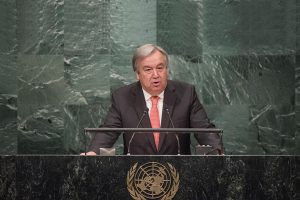Ahead of the UN Climate Action Summit convened by the UN Secretary-General on 23 September, scientists issued yet another warning: a tripling of ambition in countries’ climate pledges is needed to keep the increase in global average temperatures below 2°C above preindustrial levels, and even more action is required if we want to limit warming to 1.5°C. These repeated warnings underscore that the Paris Agreement on climate change cannot do all the heavy lifting on its own. The climate crisis requires an all-hands-on-deck approach to international governance. Other international regimes need to support climate action. This notably includes international trade agreements.
The need for trade policy to play a constructive role in combating climate change should no longer be in doubt. Trade is to play a facilitative role in achieving the SDGs, and Director-General of the World Trade Organization (WTO), Roberto Azevêdo, acknowledged that “the broader international community, including the WTO, has to play its part” in tackling climate change.
Realizing this ambition, however, is easier said than done. Although the linkages between climate and trade regularly come up in the WTO’s Committee on Trade and Environment, any rule development related to climate change has stalled, in part due to broader challenges plaguing the Organization, and in part because reaching agreement among 164 WTO members on how trade rules could support climate change remains a distant prospect. Even a focused effort to lower tariffs for a limited list of “environmental goods,” such as wind turbines and solar photovoltaic (PV) panels, among a subset of WTO members, including the US, China, and the EU, ground to a halt due to disagreement over which goods to include.
Against this backdrop, the announcement at the Climate Action Summit by New Zealand, Costa Rica, Fiji, Iceland and Norway that they will begin negotiating a new ‘Agreement on Climate Change, Trade and Sustainability’ (ACCTS) in February 2020 is remarkable. These countries are no major economies or large greenhouse gas (GHG) emitters. As the statement launching the initiative announces, these are “relatively small, outward facing, trade-dependent countries” that aim for sustainable and inclusive economic development. The successful adoption of an ACCTS would be about climate leadership by example, not leadership through structural economic power.
The contents of the agreement remain to be determined, but the intention is to at least remove barriers to trade in environmental goods and services, eliminate fossil fuel subsidies, and develop guidelines for voluntary eco-labeling programmes. This broad scope breaks new ground in several ways. First, although the 21 members of the Asia-Pacific Economic Cooperation (APEC) forum – to which New Zealand belongs – already agreed on a list of environmental goods in 2011, extending the negotiations to environmental services will further support the diffusion and uptake of climate-friendly technologies. Second, creating binding rules on the removal of environmentally harmful fossil fuel subsidies would constitute a major advancement compared with the existing voluntary and vaguely defined commitments made by the Group of 20 (G20) and APEC to phase out such subsidies.
Successfully concluding these negotiations would set an important precedent for multilateral and plurilateral trade talks. These small countries can induce normative change by showing that trade can be a tool to achieve climate and sustainable development goals, and that it is possible to develop rules to this end. However, to ensure long-term success, several conditions need to be met.
First, the commitments need to be credible and demonstrate that the ACCTS countries are serious in making trade policy work for climate change. This could be shown by agreeing on low and binding tariffs for imports of environmental goods. Moreover, it will be key to not only remove subsidies for fossil fuel consumption, but also tax breaks and other support for fossil fuel producers. In addition, to ensure that commitments are fulfilled, it will be important to back them up with provisions on enforcement and dispute settlement.
Second, the agreement will ultimately need to attract many more participants. The EU, which already seeks to align its trade agreements with climate action, is a clear candidate. At the Climate Action Summit, French President Emmanuel Macron called upon other leaders to make their trade and climate agendas consistent. For the EU, joining the agreement would be a way to bolster its climate leadership credentials and go beyond rhetorical calls to not conclude trade agreements with the already dwindling number of non-Parties to the Paris Agreement. Other prospective candidates include APEC members that agreed on the list of environmental goods, signatories of the 2015 Communiqué on fossil fuel subsidy reform, and the countries that agreed in 2018 to advance discussions on fossil fuel subsidies under the auspices of the WTO. In the long run, it will be key to scale the outcomes of the ACCTS to the multilateral level.
Third, the negotiations will need to overcome concerns that trade agreements are bad for the environment by being conducted in an open and transparent fashion. Although some negotiations need to be carried out behind closed doors, mechanisms to consult or otherwise receive input from civil society organizations (CSOs) will be important to ensure the agreement’s legitimacy. Moreover, given the substance of the agreement, it will be key to allow for insights from the scientific community. Lastly, transparency about the intentions of the negotiating partners, actions taken, and results achieved can help build trust with other countries, and hence attract further participation.
In the near-absence of progress at the multilateral and plurilateral level on these issues, five small countries have a unique opportunity to create a “trailblazer agreement” on trade and climate change. Their leadership in advancing this agenda should be welcomed.
* * *
This article was written by Harro van Asselt, University of Eastern Finland; Stockholm Environment Institute (SEI).

